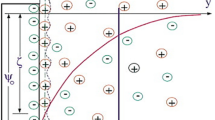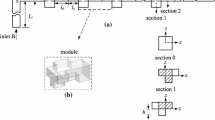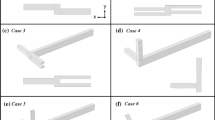Abstract
Electroosmotic flow in microchannels is restricted to low Reynolds number regimes. Since the inertia forces are extremely weak in such regimes, turbulent conditions do not readily develop, and hence species mixing occurs primarily as a result of diffusion. Consequently, achieving a thorough species mixing generally relies upon the use of extended mixing channels. This paper aims to improve the mixing performance of conventional side channel type micromixers by specifying the optimal driving voltages to be applied to each channel. In the proposed approach, the driving voltages are identified by constructing a simple theoretical scheme based on a ‘flow-rate-ratio’ model and Kirchhoff’s law. The numerical and experimental results confirm that the optimal voltage control approach provides a better mixing performance than the use of a single driving voltage gradient.
Similar content being viewed by others
References
1. C.H. Chen, H. Lin, S.K. Lele and J.G. Santiago, Journal of Fluid Mechanics 524, 263 (2005).
2. L.M. Fu and R.J. Yang, Electrophoresis 24, 1253 (2003).
3. L.M. Fu, R.J. Yang, G.B. Lee and Y.J. Pan, Electrophoresis 24, 3026 (2003).
4. L.M. Fu, R.J. Yang, C.H. Lin and Y.S. Chien, Electrophoresis 5, 1814 (2005).
5. R.J. Hunter, Zeta Potential in Colloid Science Principles and Applications, Academic Press, Florida, (1981).
6. T.J. Johnson, D. Ross and L.E. Locascio, Analytical Chemistry 74, 45 (2002).
7. C.H. Lin, G.B. Lee, Y.H. Lin and G.L. Chang, Journal of Micromechanics Microengineering 11, 726 (2001).
8. S.D. Müller, I. Mezié, J.H. Walther and P. Koumoutsakos, Computers and Fluids 33, 521 (2004).
9. P. Tabeling, M. Chabert, A. Dodge, C. Jullien and F. Okkels, Philosophical Transactions of the Royal Society of London. A 362, 987 (2004).
10. S.H. Wong, P. Bryant, M. Ward and C. Wharton, Sensors and Actuators B 95, 414 (2003).
11. Z.Wu and N.T. Nguyen, Biomedical Microdevices 7, 13 (2005).
12. R.J. Yang, C.H. Wu, T.I Tseng, S.B. Huang and G.B. Lee, Japanese Journal of Applied Physics 44, 7634 (2005).
Author information
Authors and Affiliations
Corresponding author
Rights and permissions
About this article
Cite this article
Wu, CH., Yang, RJ. Improving the mixing performance of side channel type micromixers using an optimal voltage control model. Biomed Microdevices 8, 119–131 (2006). https://doi.org/10.1007/s10544-006-7707-5
Issue Date:
DOI: https://doi.org/10.1007/s10544-006-7707-5




